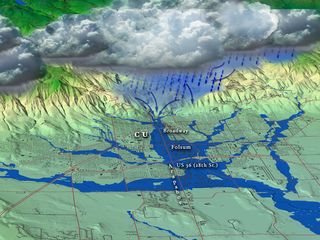Colorado Floods: What Happens to All That Water?

As flood waters slowly begin to recede from central Colorado, new flood warnings have cropped up downstream in Nebraska.
Colorado's South Platte River, which runs northeast from the middle of the state into the southwest corner of Nebraska, has taken the burden of much of the record rainwater that hasn't already seeped into the ground.
A surge in the river began approaching the Nebraska border at about midnight last night (Sept. 17), according to Dave Nettles, an engineer with the Colorado Division of Water Resources, but the crest of the surge had not yet reached the border as of this morning. The crest will likely arrive today, Nettles said, but the exact timing remains uncertain. [Colorado Flood Photos: 100-Year-Storm]
The intensity of flooding is expected to be less severe in Nebraska than it was in Colorado, since a portion of the water has already seeped into ground aquifers, and because no new water has been added to the system in the last couple of days, said Robert Kimbrough, a hydrologist for the U.S. Geological Survey in Denver.
Nebraska's relatively flat landscape also makes it less prone to flooding than mountainous regions of Colorado, because streambeds are wider and can handle more water there.
"The channels are pretty permeable and wide in Nebraska, so it won't be like it is in mountainous regions like Colorado, where there is less space for water and the water just goes up," said Vitaly Zlotnik, a hydrogeologist at the University of Nebraska-Lincoln.
As early as last Friday (Sept. 13), Colorado water officials correctly predicted that floods would reach Nebraska today, and warned Nebraska officials accordingly. The National Weather Service has issued a series of flood warnings in the Southwest region of the state, and predicts minor to moderate flooding for the remainder of the week.
Sign up for the Live Science daily newsletter now
Get the world’s most fascinating discoveries delivered straight to your inbox.
The South Platte River flows into Nebraska's Platte River, which flows eastward along the southern half of the state. The river widens as it gets further from Colorado, and will thus be able to better accommodate the surge further into the state. Any water that breaches the river thereafter will likely seep into groundwater aquifers, and the rest will run eastward and eventually flow into the Missouri River.
Follow Laura Poppick on Twitter. Follow LiveScience on Twitter, Facebookand Google+. Original article on LiveScience.

